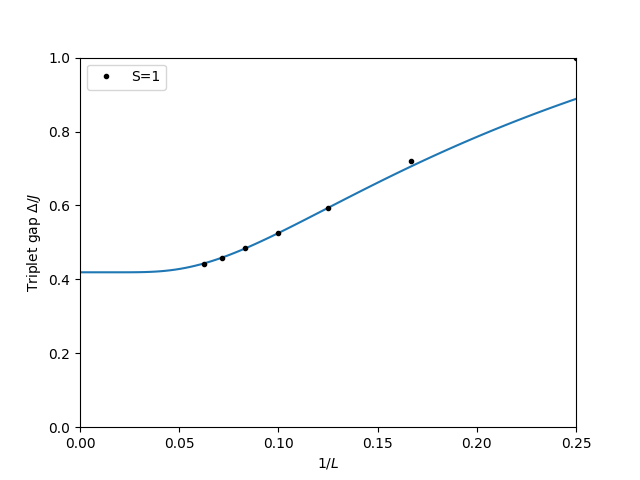精确对角化
作为稀疏矩阵精确对角化方法的示例,我们将获得自旋链模型的三重态能隙作为系统大小的函数。
第一步是导入所需的包。
import pyalps
import numpy as np
import matplotlib.pyplot as plt
import pyalps.plot
import pyalps.fit_wrapper as fw然后我们准备每组输入参数并将它们写入 ALPS 期望的格式。
parms = []
for l in [4, 6, 8, 10, 12, 14, 16]:
for sz in [0, 1]:
parms.append(
{
'LATTICE' : "chain lattice",
'MODEL' : "spin",
'local_S' : 1,
'J' : 1,
'L' : l,
'CONSERVED_QUANTUMNUMBERS' : 'Sz',
'Sz_total' : sz
}
)
#写入输入文件并运行模拟
input_file = pyalps.writeInputFiles('parm2a',parms)然后我们对每组参数运行 sparsediag:
res = pyalps.runApplication('sparsediag',input_file)我们随后加载所有状态的测量数据:
data = pyalps.loadSpectra(pyalps.getResultFiles(prefix='parm2a'))并提取每个模拟中所有动量的基态能量。
lengths = []
min_energies = {}
for sim in data:
l = int(sim[0].props['L'])
if l not in lengths: lengths.append(l)
sz = int(sim[0].props['Sz_total'])
all_energies = []
for sec in sim:
all_energies += list(sec.y)
min_energies[(l,sz)]= np.min(all_energies)最后,我们绘制三重态能隙作为系统大小函数的图表。
gapplot = pyalps.DataSet()
gapplot.x = 1./np.sort(lengths)
gapplot.y = [min_energies[(l,1)] -min_energies[(l,0)] for l in np.sort(lengths)]
gapplot.props['xlabel']='$1/L$'
gapplot.props['ylabel']='三重态能隙 $\Delta/J$'
gapplot.props['label']='S=1'
gapplot.props['line']='.'
plt.figure()
pyalps.plot.plot(gapplot)
plt.legend()
plt.xlim(0,0.25)
plt.ylim(0,1.0)
pars = [fw.Parameter(0.411), fw.Parameter(1000), fw.Parameter(1)]
f = lambda self, x, p: p[0]()+p[1]()*np.exp(-x/p[2]())
# 我们只拟合从 8 到 16 的范围
fw.fit(None, f, pars, np.array(gapplot.y)[2:], np.sort(lengths)[2:])
x = np.linspace(0.0001, 1./min(lengths), 100)
plt.plot(x, f(None, 1/x, pars))
plt.show()最终结果应该如下所示:
